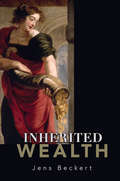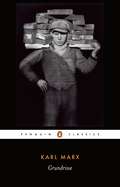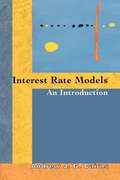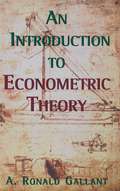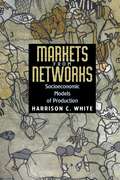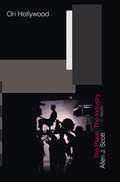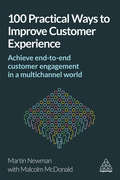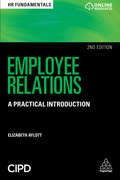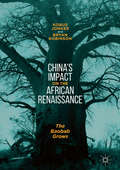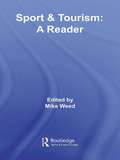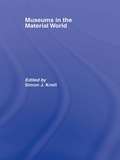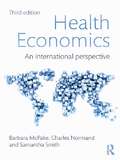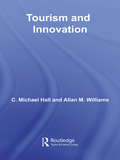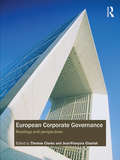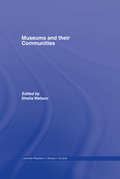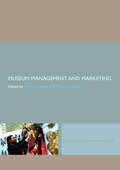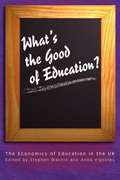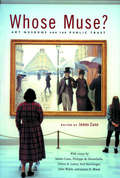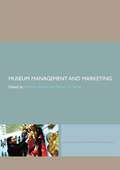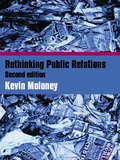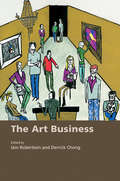- Table View
- List View
Inherited Wealth (PDF)
by Jens Beckert Thomas DunlapHow to regulate the transfer of wealth from one generation to the next has been hotly debated among politicians, legal scholars, sociologists, economists, and philosophers for centuries. Bequeathing wealth is a vital ingredient of family solidarity. But does the reproduction of social inequality through inheritance square with the principle of equal opportunity? Does democracy suffer when family wealth becomes political power? The first in-depth, comparative study of the development of inheritance law in the United States, France, and Germany, Inherited Wealth investigates longstanding political and intellectual debates over inheritance laws and explains why these laws still differ so greatly among these countries. Using a sociological perspective, Jens Beckert sheds light on the four most controversial issues in inheritance law during the past two centuries: the freedom to dispose of one's property as one wishes, the rights of family members to the wealth bequeathed, the dissolution of entails (which restrict inheritance to specific classes of heirs), and estate taxation. Beckert shows that while the United States, France, and Germany have all long defended inheritance rights based on the notion of individual property rights, they have justified limitations on inheritance rights in profoundly different ways, reflecting culturally specific ways of understanding the problems of inherited wealth.
Grundrisse: Foundations of the Critique of Political Economy (The\pelican Marx Library)
by Karl MarxWritten during the winter of 1857-8, the Grundrisse was considered by Marx to be the first scientific elaboration of communist theory. A collection of seven notebooks on capital and money, it both develops the arguments outlined in the Communist Manifesto (1848) and explores the themes and theses that were to dominate his great later work Capital. Here, for the first time, Marx set out his own version of Hegel's dialectics and developed his mature views on labour, surplus value and profit, offering many fresh insights into alienation, automation and the dangers of capitalist society. Yet while the theories in Grundrisse make it a vital precursor to Capital, it also provides invaluable descriptions of Marx's wider-ranging philosophy, making it a unique insight into his beliefs and hopes for the foundation of a communist state.
Interest Rate Models: An Introduction (PDF)
by Andrew J. CairnsThe field of financial mathematics has developed tremendously over the past thirty years, and the underlying models that have taken shape in interest rate markets and bond markets, being much richer in structure than equity-derivative models, are particularly fascinating and complex. This book introduces the tools required for the arbitrage-free modelling of the dynamics of these markets. Andrew Cairns addresses not only seminal works but also modern developments. Refreshingly broad in scope, covering numerical methods, credit risk, and descriptive models, and with an approachable sequence of opening chapters, Interest Rate Models will make readers--be they graduate students, academics, or practitioners--confident enough to develop their own interest rate models or to price nonstandard derivatives using existing models. The mathematical chapters begin with the simple binomial model that introduces many core ideas. But the main chapters work their way systematically through all of the main developments in continuous-time interest rate modelling. The book describes fully the broad range of approaches to interest rate modelling: short-rate models, no-arbitrage models, the Heath-Jarrow-Morton framework, multifactor models, forward measures, positive-interest models, and market models. Later chapters cover some related topics, including numerical methods, credit risk, and model calibration. Significantly, the book develops the martingale approach to bond pricing in detail, concentrating on risk-neutral pricing, before later exploring recent advances in interest rate modelling where different pricing measures are important.
An Introduction to Econometric Theory: Measure-Theoretic Probability and Statistics with Applications to Economics (PDF)
by A. Ronald GallantIntended primarily to prepare first-year graduate students for their ongoing work in econometrics, economic theory, and finance, this innovative book presents the fundamental concepts of theoretical econometrics, from measure-theoretic probability to statistics. A. Ronald Gallant covers these topics at an introductory level and develops the ideas to the point where they can be applied. He thereby provides the reader not only with a basic grasp of the key empirical tools but with sound intuition as well. In addition to covering the basic tools of empirical work in economics and finance, Gallant devotes particular attention to motivating ideas and presenting them as the solution to practical problems. For example, he presents correlation, regression, and conditional expectation as a means of obtaining the best approximation of one random variable by some function of another. He considers linear, polynomial, and unrestricted functions, and leads the reader to the notion of conditioning on a sigma-algebra as a means for finding the unrestricted solution. The reader thus gains an understanding of the relationships among linear, polynomial, and unrestricted solutions. Proofs of results are presented when the proof itself aids understanding or when the proof technique has practical value. A major text-treatise by one of the leading scholars in this field, An Introduction to Econometric Theory will prove valuable not only to graduate students but also to all economists, statisticians, and finance professionals interested in the ideas and implications of theoretical econometrics.
Markets from Networks: Socioeconomic Models of Production (PDF)
by Harrison C. WhiteIn Markets from Networks, one of America's most influential sociologists unveils a groundbreaking theory of the market economy. Arguing that most economists use overly abstract models of how the economy operates, Harrison White seeks a richer, more empirically based alternative. In doing so, he offers a more lucid, generalized treatment of the market models described in his important earlier work in order to show how any given market is situated in a broader exchange economy. White argues that the key to economic action is that producers seek market niches to maximize profit and minimize competition. As they do so, they base production decisions not only on anticipated costs from suppliers and anticipated demand from buyers, but also by looking at their competitors. In fact, White asserts, producers act less in response to actual demand than by anticipating it: they gauge where competitors have found demand and thus determine what they can do that is similar and yet different enough to give themselves a special niche. Building on these and related insights, White creates new mathematical models of how the economy works and how the interaction of its sectors creates mutual protection from the uncertainties of business. These models provide new ways of accounting for profits, prices, market shares, and other vital economic phenomena. He shows, for example, that prices are determined by the coalescing of local variables rather than set in terms of averages as implied by the ''law'' of supply and demand. The model of ''pure'' competition favored by economics is deficient, he concludes, as it fails to account for the varied circumstances of particular industries. Throughout, White draws extensively on case studies of American businesses and on recent mathematical and sociological work on networks. Rivaling standard economic theories with its rich empirical grounding, sheer originality, and scholarly rigor, Markets from Networks will resonate in economics and economic sociology for years to come.
On Hollywood: The Place, The Industry (PDF)
by Allen J. ScottWhy is the U.S. motion picture industry concentrated in Hollywood and why does it remain there in the age of globalization? Allen Scott uses the tools of economic geography to explore these questions and to provide a number of highly original answers. The conceptual roots of his analysis go back to Alfred Marshall's theory of industrial districts and pick up on modern ideas about business clusters as sites of efficient and innovative production. On Hollywood builds on this work by adding major new empirical elements. By examining the history of motion-picture production from the early twentieth century to the present through this analytic lens, Scott is able to show why the industry (which was initially focused on New York) had shifted the majority of its production to Southern California by 1919. He also addresses in detail the bases of Hollywood's long-standing creative energies and competitive advantages. At the same time, the book explores the steady globalization of Hollywood's market reach as well as the cultural and political dilemmas posed by this phenomenon. On Hollywood will appeal not only to general readers with an interest in the motion-picture industry, but also to economic geographers, business professionals, regional development practitioners, and cultural theorists as well.
100 Practical Ways to Improve Customer Experience: Achieve End-to-end Customer Engagement In A Multi-channel World
by Martin Newman Malcolm McDonaldVirtually all consumer-facing businesses talk about putting the customer first, but in reality, few deliver on this as effectively as they could. 100 Practical Ways to Improve Customer Experience walks readers through a wealth of practical tips, tools, guidelines and frameworks, for implementing customer-focused marketing strategies at every step of the customer journey. By ensuring that the customer remains the key focus, companies can identify areas in need of improvement and implement relevant steps throughout the value chain to transform their business. A unique blend of strategy and best practice, 100 Practical Ways to Improve Customer Experience has a particular focus on multi-channel industries such as retail, FMCG, travel, financial services, leisure, food and beverage, and automotive. These industries are all facing major disruption from trendsetting brands such as Uber, AirBnB and Amazon, and as such, now face more pressure than ever to adopt new practices and remain relevant in a continually competitive marketplace. Featuring case studies packed full of practical examples, this book is a unique and valuable resource for both senior industry professionals looking to transform their business and MBA students.
Employee Relations (Hr Fundamentals Ser. #2)
by Elizabeth AylottFostering positive relationships between employers and employees is crucial to ensure employee commitment and engagement, as well as overall business performance. Employee Relations is a practical guide to the principles and practice of employee relations in the workplace. Covering the key areas such as conflict and dispute resolution, dismissal and redundancies, rights and ethics, it equips you with the skills and knowledge you need to plan, implement and assess employee relations in any type of organization. Practical diagnostic tools and a variety of real-life examples from organizations including Amazon, HSBC and the UK Police Force are found throughout. This fully revised second edition of Employee Relations features new material on the gig economy, the virtual workplace, and recent legislation changes, and is more closely linked to the CIPD professions map. New online supporting resources include a series of templates, questionnaires and further tools to help evaluate and support the development of an effective employee relations strategy. HR Fundamentals is a series of succinct, practical guides for students and those in the early stages of their HR careers. They are endorsed by the Chartered Institute of Personnel and Development (CIPD), the UK professional body for HR and people development, which has over 145,000 members worldwide.
China’s Impact on the African Renaissance: The Baobab Grows
by Kobus Jonker Bryan RobinsonThis book provides the first comprehensive academic study of what China's trade with, and investment in, African countries mean for the socio-economic well-being of the continent. Based on the African Tree of Organic Growth Framework developed in the book, Jonker and Robinson outline the factors necessary in realizing Africa's Renaissance vision and the impact that the Chinese might have on this process. Using the metaphor of the Baobab tree, the authors analyze the historical, cultural and economic contexts within African countries, the channels available to produce development and growth, and the fruits or social and economic well-being created by this integrated process. The book takes readers on a journey of numerous African examples and case studies, describing and analyzing the challenges and complexities of countries in their desire to achieve organic, cultural, scientific and economic renewal, and the improvement of the well-being of their citizens. This book will be of great value to economists, people who wish to do business in Africa, China-watchers, those who are following the development and growth of Africa, and more.
China’s Impact on the African Renaissance: The Baobab Grows
by Kobus Jonker Bryan RobinsonThis book provides the first comprehensive academic study of what China's trade with, and investment in, African countries mean for the socio-economic well-being of the continent. Based on the African Tree of Organic Growth Framework developed in the book, Jonker and Robinson outline the factors necessary in realizing Africa's Renaissance vision and the impact that the Chinese might have on this process. Using the metaphor of the Baobab tree, the authors analyze the historical, cultural and economic contexts within African countries, the channels available to produce development and growth, and the fruits or social and economic well-being created by this integrated process. The book takes readers on a journey of numerous African examples and case studies, describing and analyzing the challenges and complexities of countries in their desire to achieve organic, cultural, scientific and economic renewal, and the improvement of the well-being of their citizens. This book will be of great value to economists, people who wish to do business in Africa, China-watchers, those who are following the development and growth of Africa, and more.
Sport & Tourism: A Reader
by Mike WeedThis Reader provides comprehensive coverage of the scholarly literature in sports tourism. Divided into four parts, each prefaced by a substantial introduction from the editor, it presents the key themes, state of the art research and new conceptual thinking in sports tourism studies. Topics covered include: understanding the sports tourist impacts of sports tourism policy and management considerations for sports tourism approaches to research in sports tourism Articles cover a broad range of the new research that has a bearing on sports tourism and include diverse areas such as the economic analysis of sports events, sub-cultures in sports tourism, adventure tourism and tourism policy.
Museums in the Material World (Leicester Readers in Museum Studies)
by Simon KnellMuseums in the Material World seeks to both introduce classic and thought-provoking pieces and contrast them with articles which reveal grounded practice. The articles are selected from across the full breadth of museum disciplines and are linked by a logical narrative, as detailed in the section introductions. The choice of articles reveals how the debate has opened up on disciplinary practice, how the practices of the past have been critiqued and in some cases replaced, how it has become necessary to look beyond and outside disciplinary boundaries, and how old practices can in many circumstances continue to have validity. Museums in the Material World is about broadening horizons and moving museum studies students, and others, beyond the narrow confines of their own disciplinary thinking or indeed any narrow conception of collections. In essence, this is a book about the practice of interpretation and will therefore be of great use to those students and museum practitioners involved in the field of material culture in museums.
Health Economics: An International Perspective
by Barbara McPake Charles Normand Samantha Smith Anne NolanThis third edition of Barbara McPake and Charles Normand’s textbook confirms it as providing the only properly international treatment of health economics on the market. A key tenet of the book is its analysis of comparative health systems across borders, and the text has been updated and revised to take account of changes in a host of countries. Barack Obama’s reforms in the United States are considered alongside the provision of healthcare in China, providing a unique overview of these different approaches. The introduction of performance related payment in various forms is appraised, with the experience of developing countries such as Cambodia, Rwanda and Uganda important in this regard. An overview of the range of mathematical techniques available to perform economic evaluation in healthcare is also introduced, although the text avoids becoming too technical. In all, the text builds on the success of the first edition and provides the perfect introduction to the fast changing world of health economics.
Health Economics: An International Perspective
by Barbara McPake Charles Normand Samantha Smith Anne NolanThis third edition of Barbara McPake and Charles Normand’s textbook confirms it as providing the only properly international treatment of health economics on the market. A key tenet of the book is its analysis of comparative health systems across borders, and the text has been updated and revised to take account of changes in a host of countries. Barack Obama’s reforms in the United States are considered alongside the provision of healthcare in China, providing a unique overview of these different approaches. The introduction of performance related payment in various forms is appraised, with the experience of developing countries such as Cambodia, Rwanda and Uganda important in this regard. An overview of the range of mathematical techniques available to perform economic evaluation in healthcare is also introduced, although the text avoids becoming too technical. In all, the text builds on the success of the first edition and provides the perfect introduction to the fast changing world of health economics.
Tourism and Innovation: Perspectives On Systems, Restructuring And Innovations (Contemporary Geographies of Leisure, Tourism and Mobility)
by Michael C. Hall Allan WilliamsTourism is often described as an industry with high growth rates, and it is subject to radical change in how it is produced and consumed. However, there is still a relatively poor understanding of how such changes are brought about – that is, through innovation. This book is the first to provide a comprehensive review of innovation in tourism, while also considering how tourism itself contributes to innovative local, regional and national development strategies. This timely book places tourism innovation in the context of current academic and policy concerns relating to knowledge, competition, and the management of change. A substantial introductory chapter provides an overview of what makes innovation in tourism both distinctive from, and similar to innovation in other economic sectors. This is followed by three general scene setting chapters which explore how competition and the search for competitiveness drive tourism innovation, how knowledge transfers and knowledge creation lead the process, and how institutions shape innovation. These provide a coherent theoretical framework for understanding the roles of different agencies in innovation, ranging from the state, to the firm, to the consumer. The next four chapters analyze innovation at different scales. Two chapters review the territorial dimensions of innovation through the fresh perspectives of the national and regional innovation systems, followed by reviews of the determinants of innovation in the firm, and the contested and complex role of entrepreneurship. The final chapter summarises the importance of understanding tourism innovation. This is a groundbreaking volume which provides an accessible introduction to a key but neglected topic. It provides a readable account of the multidisciplinary research on innovation and relates the emerging theoretical framework to tourism. A clear conceptual framework is complemented by fifty boxes which provide a range of illustrative international case studies. This book will be a useful guide for researchers and students of tourism studies, management and business and geography.
Tourism and Innovation (Contemporary Geographies of Leisure, Tourism and Mobility)
by Michael C. Hall Allan WilliamsTourism is often described as an industry with high growth rates, and it is subject to radical change in how it is produced and consumed. However, there is still a relatively poor understanding of how such changes are brought about – that is, through innovation. This book is the first to provide a comprehensive review of innovation in tourism, while also considering how tourism itself contributes to innovative local, regional and national development strategies. This timely book places tourism innovation in the context of current academic and policy concerns relating to knowledge, competition, and the management of change. A substantial introductory chapter provides an overview of what makes innovation in tourism both distinctive from, and similar to innovation in other economic sectors. This is followed by three general scene setting chapters which explore how competition and the search for competitiveness drive tourism innovation, how knowledge transfers and knowledge creation lead the process, and how institutions shape innovation. These provide a coherent theoretical framework for understanding the roles of different agencies in innovation, ranging from the state, to the firm, to the consumer. The next four chapters analyze innovation at different scales. Two chapters review the territorial dimensions of innovation through the fresh perspectives of the national and regional innovation systems, followed by reviews of the determinants of innovation in the firm, and the contested and complex role of entrepreneurship. The final chapter summarises the importance of understanding tourism innovation. This is a groundbreaking volume which provides an accessible introduction to a key but neglected topic. It provides a readable account of the multidisciplinary research on innovation and relates the emerging theoretical framework to tourism. A clear conceptual framework is complemented by fifty boxes which provide a range of illustrative international case studies. This book will be a useful guide for researchers and students of tourism studies, management and business and geography.
European Corporate Governance: Readings and Perspectives
by Thomas Clarke Jean-Francois ChanlatFor decades, Europe has sought to become more financially integrated with the United States and thus European legal institutions, regulatory, governance and accounting practices have faced pressures to adapt to international competitive markets. Against this backdrop, European corporate governance systems have been criticized as being less efficient than the Anglo-American market based systems. This textbook examines the unique dimensions and qualities of European corporate governance. Reforms of key institutions, the doctrine of shareholder value and the seemingly irresistible growth of CEO power and reward are critically analyzed. The book brings out the richness of European corporate governance systems, as well as highlighting historical weaknesses that will require further work for a sustainable corporate governance environment in the future. In light of the most severe financial crisis since the 1930s, this intelligent look at European corporate governance is a vital textbook for courses on corporate governance and a great supplementary textbook on a host of business, management and accounting classes.
Museums and their Communities (Leicester Readers in Museum Studies)
by Sheila WatsonUsing case studies drawn from all areas of museum studies, Museums and their Communities explores the museums as a site of representation, identity and memory, and considers how it can influence its community. Focusing on the museum as an institution, and its social and cultural setting, Sheila Watson examines how museums use their roles as informers and educators to empower, or to ignore, communities. Looking at the current debates about the role of the museum, she considers contested values in museum functions and examines provision, power, ownership, responsibility, and institutional issues. This book is of great relevance for all disciplines as it explores and questions the role of the museum in modern society.
Museums and their Communities (Leicester Readers in Museum Studies)
by Sheila WatsonUsing case studies drawn from all areas of museum studies, Museums and their Communities explores the museums as a site of representation, identity and memory, and considers how it can influence its community. Focusing on the museum as an institution, and its social and cultural setting, Sheila Watson examines how museums use their roles as informers and educators to empower, or to ignore, communities. Looking at the current debates about the role of the museum, she considers contested values in museum functions and examines provision, power, ownership, responsibility, and institutional issues. This book is of great relevance for all disciplines as it explores and questions the role of the museum in modern society.
Museum Management and Marketing (Leicester Readers in Museum Studies)
by Richard Sandell Robert R. JanesDrawing together a selection of high quality, intellectually robust and stimulating articles on both theoretical and practice-based developments in the field, this Reader investigates the closely linked areas of management and marketing in the museum. The articles, from established and world-renowned contributors, practitioners and writers at the leading edge of their fields, deal with the museum context of management and how marketing and management practices must take account of the specifics of the museum and the not-for-profit ethos. Key writings from broader literature are included, and the collection of key writings on the investigation and study of management and marketing in the museum are of great benefit not only to those studying the subject, but also to professionals working and developing within the field.
What's the Good of Education?: The Economics of Education in the UK
by Stephen Machin Anna VignolesVolumes have been written about the value of more and better education. But is there sufficient evidence to support the commonly held belief that we, as individuals and as a community, should be investing more in education? This book explores that question in unprecedented detail, drawing on empirical evidence from an impressive array of sources. While much of the focus is on the educational system in the United Kingdom, the book offers lessons of international applicability. A state-of-the-art compendium on education policy and its impact on educational attainment, the book examines numerous large-scale data sources on individual pupils and schools. The questions the book considers are far-ranging: How much do teachers matter for children's educational attainment? What payoff do people get from acquiring more education when they enter the labor market? How well do education systems function to provide employers with the skills they want? The book concludes by issuing some strong policy recommendations and offering an evaluation of what does and does not work in improving educational attainment. The recommendations address such issues as school effectiveness, education financing, individual investment in education, government education initiatives, higher education, labor market rewards, and lifelong learning.
Whose Muse?: Art Museums and the Public Trust (PDF)
by James Cuno Philippe De Montebello Neil MacGregor John Walsh Glenn D. Lowry James N. WoodDuring the economic boom of the 1990s, art museums expanded dramatically in size, scope, and ambition. They came to be seen as new civic centers: on the one hand as places of entertainment, leisure, and commerce, on the other as socially therapeutic institutions. But museums were also criticized for everything from elitism to looting or illegally exporting works from other countries, to exhibiting works offensive to the public taste. Whose Muse? brings together five directors of leading American and British art museums who together offer a forward-looking alternative to such prevailing views. While their approaches differ, certain themes recur: As museums have become increasingly complex and costly to manage, and as government support has waned, the temptation is great to follow policies driven not by a mission but by the market. However, the directors concur that public trust can be upheld only if museums continue to see their core mission as building collections that reflect a nation's artistic legacy and providing informed and unfettered access to them. The book, based on a lecture series of the same title held in 2000-2001 by the Harvard Program for Art Museum Directors, also includes an introduction by Cuno and a fascinating--and surprisingly frank--roundtable discussion among the participating directors. A rare collection of sustained reflections by prominent museum directors on the current state of affairs in their profession, this book is without equal. It will be read widely not only by museum professionals, trustees, critics, and scholars, but also by the art-loving public itself.
Museum Management and Marketing (Leicester Readers in Museum Studies)
by Richard Sandell Robert R. JanesDrawing together a selection of high quality, intellectually robust and stimulating articles on both theoretical and practice-based developments in the field, this Reader investigates the closely linked areas of management and marketing in the museum. The articles, from established and world-renowned contributors, practitioners and writers at the leading edge of their fields, deal with the museum context of management and how marketing and management practices must take account of the specifics of the museum and the not-for-profit ethos. Key writings from broader literature are included, and the collection of key writings on the investigation and study of management and marketing in the museum are of great benefit not only to those studying the subject, but also to professionals working and developing within the field.
Rethinking Public Relations: PR Propaganda and Democracy
by Kevin MoloneyAll PR, whether for charities or arms manufacturers, is weak propaganda. Though it has its undeniable benefits (it grabs attention and helps circulate more information), it also has costs (such as selective messaging). This extensively revised edition of a classic text fully investigates PR, updating and expanding earlier arguments and building upon the successful first edition with new thoughts, data and evidence. Thought-provoking and stimulating, Rethinking Public Relations 2nd Edition challenges conventional PR wisdom. It develops the accepted thinking on the most important question facing PR - its relationship with democracy - and finds a balance of advantages and disadvantages which leave a residue of concern. It tackles topical issues such as: PR as a form of propaganda which flourishes in a democracy the connections between PR and journalism the media, promotions culture and persuasion. Designed to appeal to final year undergraduates, postgraduates and researchers studying public relations, media and communications studies, this book explores the most important relationship PR has – the connection with democracy – and asks what benefits or costs it brings to politics, markets and the media.
The Art Business
by Iain RobertsonBy the time you read this book, the art world may have witnessed the sale of its first $500 million painting. Whilst for some people money is anathema to art this is clearly a wealthy international industry, and a market with its own conventions and pressures. Drawing on the vast experience of Sotheby’s Institute of Art, The Art Business exposes the realities of the commercial trade in fine art and antiques. Attention is devoted to the role of auction houses, commercial galleries and art museums as key institutions, with the text divided into four thematic sections covering: technical and structural elements of the art market cultural policy and management in art business regulatory legal and ethical issues in the art world the views, through interviews, of leading art market experts. This book provides a thorough examination of contemporary issues in the art business, and the mechanisms and influences which underpin its evolution. It is essential reading for students of art history or international business, or anyone with an interest in pursuing a career in this area.
